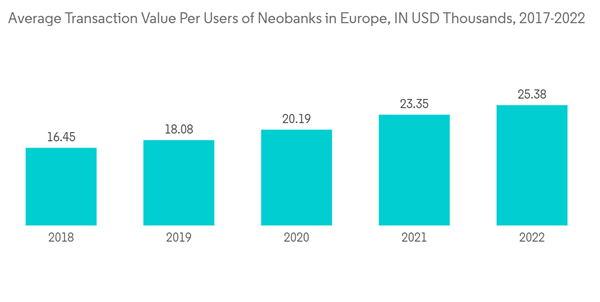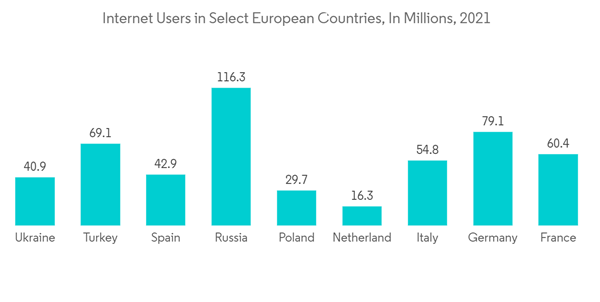Europe's Neobanking Market has generated a revenue of USD 570 billion in the current year and is poised to achieve a CAGR of 21% for the forecast period.
Neobanking is a novel banking technology that provides complete online banking solutions from opening an account to other services, without the need to go to a bank for its customers. Neobanking differs from traditional banks, as they have no physical offices & branches.
Europe holds the biggest market share in the Neobanking Market and accounts for over 30% share of the global revenue due to the establishment of multiple technology start-ups & the growing adoption of technology. The growing adoption of internet services and the increased use of smartphones are expected to accelerate market growth.
During the period of Covid-19 in 2020, Germany was having the highest user number in Digital Commerce with an average transaction value Digital commerce per user stood at a level of 2,084 US$ which stands at the second highest level after the United States. Higher and Middle-income level people contribute the most to an increase in the adoption of the Neobanking Market with restrictions made during covid for offline transactions.
Some banks are more vulnerable than others to the fallout from the COVID-19 crisis due to a weaker solvency position or individual business model characteristics. More than 2,000 small and medium-sized banks are directly supervised by national authorities. The ECB has taken measures to drastically mitigate banks funding risk, by providing new long-term central bank funding and making it easier to access this funding.
Neobanking has a grip on young customers as they are the prime target audience. Neobanking penetration is highest among 18- to 24-year-old customers. The potential growth of neobanks is driven by their low-cost model for end consumers with no or very low monthly fees on banking services such as minimum balance maintenance, deposits, and withdrawals.
To stay up with the technological transformation, there has been a tremendous need for adopting and deploying AI solutions, Big Data, and Cloud Computing, among other technologies. In addition, the neobanking model provides a low-cost framework, simple accessibility, and enhanced services. Low real estate and distribution expenses, less sophisticated IT systems, and simplified operational models enhance its cost-efficiency.
Neobanking is a novel banking technology that provides complete online banking solutions from opening an account to other services, without the need to go to a bank for its customers. Neobanking differs from traditional banks, as they have no physical offices & branches.
Europe holds the biggest market share in the Neobanking Market and accounts for over 30% share of the global revenue due to the establishment of multiple technology start-ups & the growing adoption of technology. The growing adoption of internet services and the increased use of smartphones are expected to accelerate market growth.
During the period of Covid-19 in 2020, Germany was having the highest user number in Digital Commerce with an average transaction value Digital commerce per user stood at a level of 2,084 US$ which stands at the second highest level after the United States. Higher and Middle-income level people contribute the most to an increase in the adoption of the Neobanking Market with restrictions made during covid for offline transactions.
Some banks are more vulnerable than others to the fallout from the COVID-19 crisis due to a weaker solvency position or individual business model characteristics. More than 2,000 small and medium-sized banks are directly supervised by national authorities. The ECB has taken measures to drastically mitigate banks funding risk, by providing new long-term central bank funding and making it easier to access this funding.
Europe Neobanking Market Trends
Increasing user penetration of Neobanking Apps
User penetration of Neobanking is 7.3% in 2022 and is expected to hit 13.3% by 2027. The European regulation (Payment Services Directive Law) has allowed fintech firms to directly connect with customers' data, which till now was a privilege only of traditional banks.Neobanking has a grip on young customers as they are the prime target audience. Neobanking penetration is highest among 18- to 24-year-old customers. The potential growth of neobanks is driven by their low-cost model for end consumers with no or very low monthly fees on banking services such as minimum balance maintenance, deposits, and withdrawals.
Increasing internet penetration is growing demand for neobanking
Digitalization is spreading across all industries, particularly financial transactions, and has expanded to the banking industry. Mobile payments or payments made through portable electronic devices, like a cell phone, a smartwatch, or a tablet, are an alternative to using cash, checks, or physical debit and credit cards.To stay up with the technological transformation, there has been a tremendous need for adopting and deploying AI solutions, Big Data, and Cloud Computing, among other technologies. In addition, the neobanking model provides a low-cost framework, simple accessibility, and enhanced services. Low real estate and distribution expenses, less sophisticated IT systems, and simplified operational models enhance its cost-efficiency.
Europe Neobanking Market Competitor Analysis
The report covers major players operating in the Europe Neobanking Market. In terms of market share, few of the major players currently dominate the market. There are 77 Neobank in Europe. However, with technological advancement and service innovation, domestic to international companies are increasing their market presence by securing new contracts and tapping new markets. It has major players including N26, Vivid, Ma French Bank, Orange Bank, Lunar, etc.Additional Benefits:
- The market estimate (ME) sheet in Excel format
- 3 months of analyst support
Table of Contents
1 INTRODUCTION
4 MARKET INSIGHTS AND DYNAMICS
5 MARKET SEGMENTATION
6 COMPETITIVE LANDSCAPE
Companies Mentioned (Partial List)
A selection of companies mentioned in this report includes, but is not limited to:
- N26
- Vivid
- Ma French Bank
- Orange Bank
- Lunar
- Revolut
- Bnext
- Holvi
- Monzo Bank Ltd.
- Atom Bank Plc
- Bunq
Methodology

LOADING...










